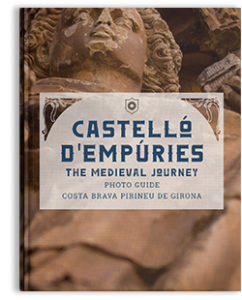

Blog

My favourite place in the Girona regions? Ask me an easier question, please.
Step back in time and discover the heritage of Girona’s Jewish communities through the ages. Taking us on a journey to the Girona, Besalú and Castelló d'Empúries of more than a thousand years ago. Want you join us?
In the blink of an eye we are transported to the ninth century. The first Jewish families have begun to settle in some of the cities around the region, establishing the Jewish quarters where they would live for more than six hundred years, during which time, their community would make a significant contribution to the economic, scientific, cultural and commercial development of these medieval cities, before being expelled from the kingdoms of Castile and Aragon in 1492 for practising a faith other than Christianity.
More than five centuries later, we can retrace the history of the Jewish communities courtesy of the magnificent legacy that has been preserved. Girona, Besalú and Castelló d’Empúries, provide the spectacular settings for a wonderful trip back in time to add to your tourism experience in the Costa Brava and Girona Pyrenees.
The word call comes from the Latin word callis, which means “narrow passageway between two walls”. It refers to the network of narrow streets, houses, workshops, stores and ceremonial buildings, such as the synagogue and baths, where the Jewish community lived and worked.

Wandering the cobbled streets of the Jewish quarter is right at the top of the list of amazing experiences on offer in Girona, providing the chance to discover one of the best-preserved Jewish quarters in the world and one of Europe’s most important medieval treasures.
The bricks used to build this part of the old town at the foot of the cathedral in the twelfth century tell the story of a community with its own life and identity that thrived here during the thirteenth and fourteenth centuries. There is nothing better than enjoying a leisurely stroll through the maze of cobbled streets and stone steps, contemplating the original architecture, discovering the hidden courtyards and drinking in the atmosphere of a place seemingly untouched by the passing of time.

The museum is located on the site that, in the fifteenth century, housed the synagogue and other spaces belonging to Girona’s Jewish community and its galleries take visitors on a very interesting tour to learn about the life and customs of the Jewish communities living in the city of Girona and other Catalan towns during medieval times.

The town of Besalú is associated with the iconic image of the seven-arched Romanesque bridge that stands across the River Fluvià, possibly the most photographed structure of its kind in the country. This is just one of the great historical delights this important medieval city holds. Besalú is, in fact, the site of numerous other hidden gems, which have seen it declared a National Historic-artistic Complex on the basis of its immense architectural value.
Besalú also had a thriving and well-established Jewish community, home to around twenty families during the medieval period. In addition to the characteristic cobbled streets, the remains of the synagogue and other vestiges, one notable element of the Jewish legacy is the Romanesque-style mikvé, the underground ritual baths, which remain the only Jewish baths to have ever been discovered in the Iberian Peninsula.
“Besalú is a town that bears the mark of history in its stones.” Josep Pla.

The trail of Jewish heritage also leads to Castelló d’Empúries, one of the most charming towns in Catalonia and neighbour to other emblematic areas on the Costa Brava, such as the Bay of Roses and the Empordà wetlands.
The Jewish community of Castelló d’Empúries was one of the most prosperous in the province during the Middle Ages and, at its peak, consisted of around three hundred people. The extensive documentation that has been preserved provides us with valuable information on their life in the town: the development of the Jewish quarter, the construction of their synagogues, their own cemetery and other buildings, their commercial activities and much more.
A first step to discovering this rich history is to walk through the irregular old town area, so typical of the medieval period, where you will find the streets and squares that made up the Jewish quarter. Also make a stop at the Museum of Medieval History of the Cúria-Prison, with a gallery dedicated to Castelló d’Empúries’s Jewish past.
A photographic walk among Jewish heritage
The photo guide Girona. The Medieval Journey provides suggestions on the best spots and tips for photographing medieval architectural heritage.
